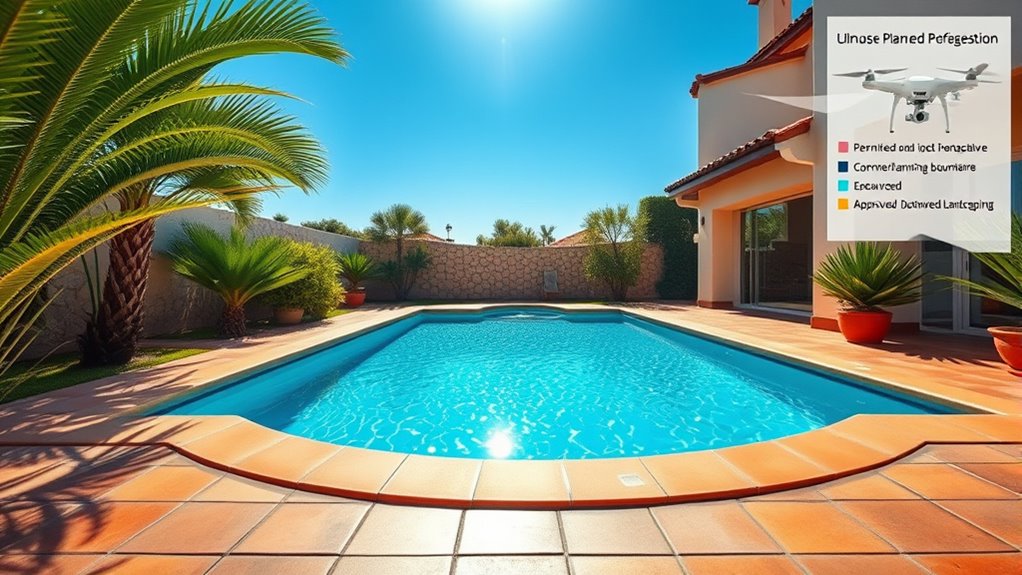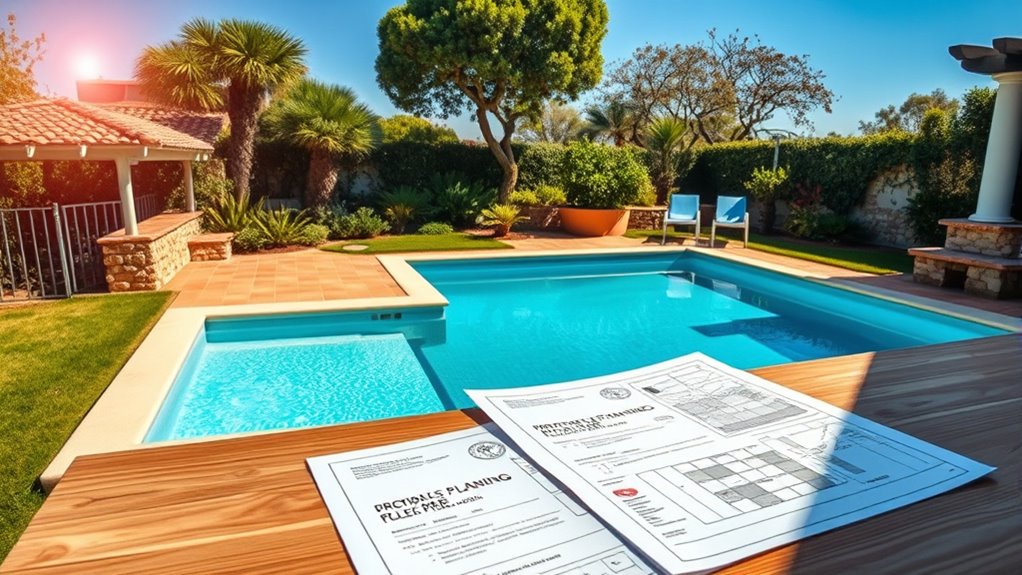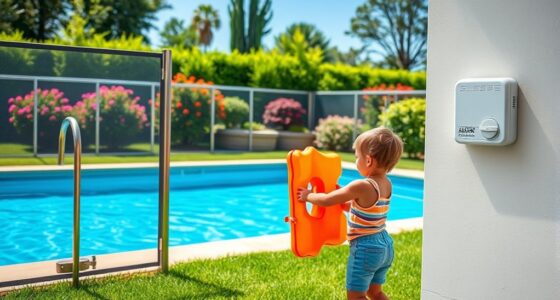To obtain planning permission for an in-ground pool in Spain, you need to guarantee your plans meet local safety, environmental, and zoning laws. This involves submitting detailed designs, specifying safety features like fencing and alarms, and demonstrating compliance with regional regulations. You might also need additional permits if your property is in protected or urban areas. Understanding these requirements helps avoid delays or legal issues—continue exploring to learn the steps to secure approval smoothly.
Key Takeaways
- Submit detailed plans including pool size, location, safety features, and construction methods to local planning authorities.
- Ensure compliance with safety standards such as fencing, locked gates, and alarms mandated by Spanish regulations.
- Verify environmental and zoning restrictions, especially near protected areas or environmentally sensitive zones.
- Obtain necessary permits by demonstrating adherence to safety, environmental, and legal standards during the application process.
- Consult local town hall or planning office early to understand regional variations and specific documentation requirements.

If you’re planning to install an in-ground pool in Spain, understanding the local planning permission requirements is essential. Spain has specific regulations to ensure that new pools comply with safety standards and legal obligations. One of the main considerations is pool safety, which covers aspects like fencing, barriers, and other protective measures to prevent accidents, especially involving children. These safety features are not just recommended—they’re often mandated by law. Failing to meet these safety standards could lead to fines or the need to modify your pool after installation. Consequently, when applying for planning permission, you must demonstrate that your pool design adheres to all safety protocols outlined by local authorities. Additionally, it’s important to be aware of the bank SWIFT/BIC codes used for international transactions related to your property investment or construction costs. Legal requirements also extend to the size, location, and impact of your pool on the surrounding environment and neighboring properties. For example, there are restrictions on how close your pool can be to property boundaries, roads, or protected areas. You need to check whether your property is in a designated zone that requires additional permits or environmental assessments. If your property is within a protected area or a conservation zone, additional permissions may be necessary, which can extend the approval process. It’s advisable to consult local town halls or planning offices early in your planning process to clarify these specifics and avoid delays. When preparing your application, you’ll need to submit detailed plans that include the pool’s dimensions, construction methods, safety features, and how it fits within your property. These plans must align with the legal requirements to ensure your project proceeds smoothly. The local authorities will review your submission, focusing on safety compliance and adherence to zoning laws. Keep in mind that some regions might have more stringent rules, especially in urban areas or tourist zones, where community safety and environmental concerns are prioritized. Obtaining the necessary planning permission isn’t just about legality; it’s also about ensuring your pool is safe for everyone who uses it. You’ll want to double-check that your plans include adequate pool safety features, such as secure fencing, locked gates, and alarms if required. Meeting these safety standards protects your family and visitors and helps you avoid potential legal liabilities. In brief, understanding and complying with the legal requirements for in-ground pools in Spain is critical for a hassle-free installation. It guarantees your pool is safe, legal, and environmentally compliant, giving you peace of mind to enjoy your new outdoor feature for years to come.
Frequently Asked Questions
Do I Need Planning Permission for a Small In-Ground Pool?
You might not need planning permission for a small in-ground pool in Spain if it meets specific size and safety regulations. However, you should consider pool safety standards and construction costs, as these factors influence your overall planning. It’s wise to check local regulations, as rules vary by region. Ensuring your pool complies with safety requirements can help avoid future issues and unexpected expenses.
How Long Does the Planning Permission Process Typically Take?
Imagine watching your pool take shape under the warm Spanish sun; the process usually takes around 4 to 8 weeks once you’ve submitted your plans. During this time, authorities assess your application, considering pool safety and construction costs. Delays can happen if additional info is needed, but staying proactive helps. Planning permission moves smoothly when you prepare thoroughly, so your dream pool becomes a reality sooner.
Are There Specific Restrictions Based on Property Location?
Yes, your property’s location influences restrictions. Local zoning laws and building codes vary by region, so check with local authorities. Some areas have height, size, or distance restrictions for pools. Coastal or protected zones often have more stringent rules. You’ll need to make sure your planned pool complies with these rules to avoid delays or penalties. Consulting local planners early helps you understand specific restrictions and streamlines the approval process.
What Documents Are Required to Apply for Permission?
Prepare your papers by gathering government guidelines, building codes, and permit fees. You’ll need detailed drawings, site plans, and proof of ownership. Your application should include a completed permit form, identification, and sometimes a certificate of compliance. Ensuring all documents are accurate and complete helps speed the process, saving you stress. Double-check local requirements, as some areas might ask for additional paperwork or specific documentation to secure your in-ground pool permit.
Can I Build an In-Ground Pool Without Planning Permission?
You can build an in-ground pool without planning permission if it meets safety standards and has minimal environmental impact. However, you should check local regulations, as some areas require permission regardless. Confirm your pool design prioritizes safety features and eco-friendly measures to prevent accidents and reduce environmental harm. Ignoring these rules can lead to fines or mandatory removal, so always verify with local authorities beforehand.
Conclusion
Getting planning permission for an in-ground pool in Spain might seem intimidating, but with the right information, it’s doable. Many believe approval is nearly impossible without hefty fees or strict regulations, but that’s not always true. By understanding local rules and working with authorities, you can turn your pool dream into reality. Don’t assume hurdles are insurmountable—often, they’re just steps to a beautiful outdoor space waiting for you.









